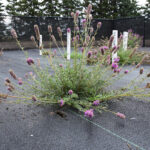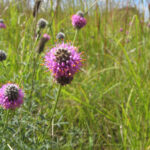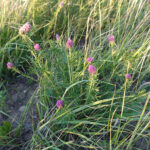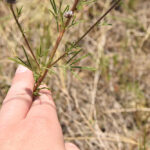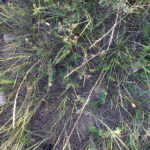Purple Prairie Clover
Dalea purpurea
General Description
Purple prairie clover is a native legume found across the prairie region. Branched stems 20-90 cm (9-40 in) tall grow from the base with bright flowers at the end of branches. Leaves consisting of 3-5 leaflets line the stems. Livestock and wildlife find purple prairie clover palatable.
Type
Native legume.
Origin
Mixed grass prairie.
Longevity
At least 10 years.
Use
Reclamation, pasture.
Optimal Time of Use
Graze purple prairie clover in the bud to bloom stage. If purple prairie clover is a minor component in the pasture mix, time grazing for the forage species that makes up the majority of the production.
Recovery After Use
Purple prairie clover regrows slowly after defoliation. It should be grazed once per year to promote longevity. Allow purple prairie clover four to six weeks of rest before the first killing frost to reduce winter injury.
Palatability/Nutritional Value
Purple prairie clover is a palatable warm-season native legume. Purple prairie clover could possibly cause bloat in the pre-bud or bud stage, but seldom is abundant enough to. Purple prairie clover has an average digestibility of 68% in the vegetative stage to 50% in late flower. Crude protein levels range from 20% in the vegetative stage to 12-13% in late flower.
Annual Precipitation min/max (mm)
350mm / 530mm
Drought Tolerance
Good drought tolerance.
Flooding Tolerance
Purple prairie clover will tolerate up to one week of saturated soils in the spring.
Winter Hardiness
Good winter hardiness.
Soil Texture Preference
Occurring on well drained, dry, coarse textured upland areas in nature, purple prairie clover is suited to sandy through loamy-clay soil textures in the Brown, Dark Brown, and Black soil zones. Purple prairie clover grows well on sandy sites.
Erosion Control
Limited value for controlling soil erosion.
Salinity Tolerance
Poor salinity tolerance.
Acidity Tolerance
Poor tolerance of acidic soils.
Alkalinity Tolerance
Unknown.
Seeds per kg
606,000 seeds/kg (275,000 seeds/lb)
Suggested Mixtures
Include with native grass species for reclamation. Can be used in mixtures with tame or seeded grass species for grazing.
Ease of Establishment
Purple prairie clover seeds benefit from scarification to maximize germination. Lower percent germination can be expected with purple prairie clover. During the establishment year purple prairie clover can grow 15-30 cm (6 to 12 in) tall.
Competitiveness
Purple prairie clover is able to persist in seeded native species mixtures used in livestock pastures. It will spread by seed if seed set occurs.
Management Considerations
Inoculate seed to encourage nitrogen fixation. Rotational grazing will assist with purple prairie clover longevity in a stand as it is highly palatable. Purple prairie clover will establish from seeds allowed to drop. It increase within a seeded pasture.
Saskatchewan Dryland Forage Species Adaptation Tool, AAFC Field Guide to Selected Native Forages, USDA Plants Database
